 French Navy – Contre-Torpilleurs de 2400 tonnes. 6 built 1927-1930, in service until 1942: Guepard, Valmy, Verdun, Bison, Lion, Vauban.
French Navy – Contre-Torpilleurs de 2400 tonnes. 6 built 1927-1930, in service until 1942: Guepard, Valmy, Verdun, Bison, Lion, Vauban.The Guepard class destroyers were a follow-up of the Jaguar class built in 1922-25. They were retrospectively called the “2400 tonnes” by contrast to the previous “2100” tonnes and officially were called “contre-torpilleurs”, since the standard or “1500 tonnes” destroyers built in the same decade were called “torpilleurs”. They were not torpedo boats in any way but destroyers. The Guepard were large destroyers, quite unique for their time. Inspirations came from war prize such as the ex-S113 and British RN flotilla leaders of 1917-1918. Their role was very different from the “torpilleurs” as they were essentially scouts for the battle fleet.

The Marine Nationale thus built a serie of uniform classes of such “contre-torpilleurs”, successively 2100, and three classes of 2400 tonnes ships, the Guepard, Aigle and Vauquelin class. They were quite uniform in design and a true departure from the previous Jaguar class. Not only they were larger, but also possessed a better range and four funnels versus three on the Jaguar (also called Chacal in many publications). The Guepard class were those which introduced this new standard, based on the experience gained with the six Jaguar class.
These vessels were called also “conducteurs de flottille” (literal translation or flotilla leaders) as their secondary role was indeed to lead 1500t standard destroyers formations, but also hunt down enemy destroyers and face enemy light scouts. For their missions they required high speed in all weather, good endurance and a powerful armament to attack and defend themselves. The French, in order to give them a qualitative edge, looked at beefing up their capabilities, and instead of the usual 120-127 mm gave them 5.5 inches or 130 mm main guns, and instead of 533 mm or 21 inches torpedo tubes, 550 mm was the French standard. On paper, this gave them a better impact. However at large, with a standard displacement of 2440 tonnes and fully loaded of 3400 tonnes, they looked still a bit under-armed and lacking speed. 36 knots was average, not stellar, but this was their fully loaded speed. On trials they reached 40 knots. This was even beaten in 1932 with the Fantasque class, capable of 37 knots FL as designed, but up to 42.5 knots on trials, with new improved main guns and more torpedo tubes.
The Guépard-class were six ships laid down in 1927 and commissioned in 1930, roughly similar to the previous Jaguar class, but with a larger hull and slightly improved plus a new gun armament with 138 mm guns (5.5 in)/40 of a new design. They were to be all named after animals of prey like the previous class, but by political decision, three were given “V” names, two battles and a field-marshal. The Guepard class fought in World War II but apart Bison sunk by the Luftwaffe in Norway in May 1940, all remaining ones were scuttled in Toulon on 27 November 1942.
Design of the class
Development
The Guepard class were a follow-up of the Chacal (or Jaguar) class destroyer or 2400 tonnes design. Bison, Guepard and Lion were ordered as part of the 1925 programme and the other three in the following year’s appropriation. The previous class showed a way forward as a general concept, but the type could be improved in many ways. This led to a generally larger design, more heavily armed, more powerful and larger overall, albeit the base concept was the same in roles and function. The main difference was their main armament: They were from 5.1 inches to 5.5 inches/40 guns. These guns fired a much larger shell, but the rate of fire due to several factors remained slow at 5-6 rounds per minutes (see later). They inherited the limitation of fire control of the 2400 tonnes in addition, with poor fire control arrangement, and if the gun’s range was on paper 19,000 m, it was way below in practice observation of the fall of shot over 13,000 m, was almost impossible with the single 3 meters coincidence rangefinder they were fitted with.
The main AA armament was still the same M1925 37 mm semi-automatic with a rate of fire of 30 rounds per minute. And with AS warfare being secondary they only had four Thornycroft depth charge throwers and two racks for twenty-four 200 kgs (440 Ib) depth charges. Torpedo armament was limited to two triple banks, which for their enormous size, seems limited, but that was not, again the design priority. Aside their main armament, arguably better, their main asset was speed. All but Guépard managed to reach 40 knots at standard displacement, and 35 to 36 knots and a half in a eight hour trials. They had AA armament modifications in 1940 but like most French warships they ended scuttled (all but Bison) in Toylon on 27 November 1942. Bison was sunk actually off Norway during the campaign in May 1940. Overall, with their large size, great speed, main armament and appeareance with their four funnels (hence the nickname in French “quatre tuyau” (four pipers)), they set a pattern repeated on the following Aigle (1930) and Vauquelin (1931). On international charts and recoignition books of the time, and in French literrature, they were still registered as “2400 tonnes”, based on their 2 441 tonnes according to the Washington treaty.
Hull and general layout
The Guépard class were much larger than the Chacal, with an overall length of 130.2 meters (427 ft 2 in) versus 126.8 m (416 ft 0.1 in), a beam of 11.5 meters (37 ft 9 in) versus 11.1 m (36 ft 5.0 in), and a draft of 4.68 meters (15 ft 4 in) versus 4.1 m (13 ft 5.4 in). They displaced 2,436 metric tons (2,398 long tons) at standard load, down to 3,220 metric tons (3,170 long tons) when deeply loaded. Their metacentric height was still high at 0.68 m (2 ft 3 in). For underwater protection they had a hull divided by 11 transverse bulkheads and then twelve watertight compartments. Their crew comprised 10 officers and 200 crewmen by peacetime, 102 officers and 224 enlisted men in wartime.
Powerplant
Like the previous Chacal class, the Guepard were powered by two geared steam turbines* driving 3.7 or 3.8-meter (12 ft 2 in or 12 ft 6 in) propellers (sources conflicts on that point). The steam was generated in four du Temple boilers, operating at a pressure of 20 kg/cm2 (1,961 kPa; 284 psi) and temperature of 215 °C (419 °F). To compare, the previous Chacal class were rated for 50,000 PS (37,000 kW; 49,000 shp) because they used smaller turbines and five older models of du Temple boilers, operating at lower temperature and pressure. As a result, the increase in power was considerable, and the Guepard class managed to reach 64,000 metric horsepower (47,000 kW; 63,000 shp) for a design speed of 36 knots (67 km/h; 41 mph).
This designed speed was easily beaten when tested on sea trials, at light load. Valmy, reached 38.53 knots (71.36 km/h; 44.34 mph) based on 76,948 PS (56,595 kW; 75,895 shp) for example. Some sources states they were capable of up to 40 knots as well. For range, the Guepard had 572 t (563 long tons) of fuel oil in storage for a range of 3,000 nautical miles (5,600 km; 3,500 mi) at 14.5 knots (26.9 km/h; 16.7 mph) very comparable to the Chacal class.
*The turbines differed by shups and yards: All but two ships combined two sets of Parsons geared steam turbines, fed by four 4 Yarrow or Penhoët boilers. Lion and Vauban were unique in that they had two of Zoelly geared steam turbines and four Yarrow or Penhoët boilers depending on the ships, respectively.
Armament
The Aigle class had a trifecta of weaponry, between he five larger 40-calibre 138.6-millimeter (5.5 in) Modèle 1923 guns (all in single shielded mounts), four semi-automatic 37 mm (1.5 in) Modèle 1927 guns in single mounts amidships and the always present two triple 550 mm (21.7 in) torpedo tubes, aft amidship. The also had a modest ASW armament combining two depth charge racks and four throwers. They also had optional smoke dischargers, optional paravanes, and optional mines, which needed the installation of rails.
These ships had a pair of depth charge chutes built into their stern, see previous designs to see the peculuarities of this design. These conveyor belts supported a total of sixteen 200-kilogram (440 lb) depth charges, with eight more in reserve. This was rounded up by four depth-charge throwers, two on each side, abreast the forward pair of funnels, and for them, the ships carried twelve 100-kilogram (220 lb) depth charges, see the details below.
Main Guns: Five 138.6mm/40 M1923
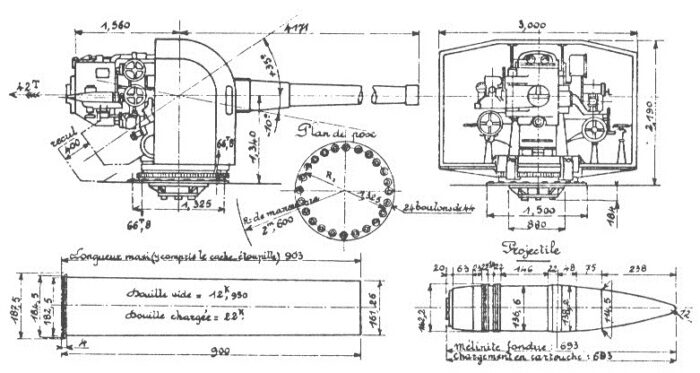
Sketch from Robert Dumas from original plans, the shell is the standard SAP 1924.
This main change compared to the Chacal class: They had a superfiring pair of main guns fore and aft of the superstructure and a fifth gun abaft the rear funnel. Same as the prvious class but with larger guns. The 138 (in many sources 140 mm) were an attempt to upgrade the 130 mm of the Chacals and give the ship a real increase of firepower. The barrels were rebored and many elements redesign to reflect the change, but they went from a basic design going back to WWI essentially, not the best as far as modern rates of fire and elevation were concerned. Due to comprises for a quicker and shoter development loop, the M1923 ended as a grossly unsatisfactory design, resulting in a slow rate of fire. The design was started soon after trials of the previous 130 mm Model 1919 already showed unsatisfactory performances. This was not resolved. The mountings had raised trunnions to allow higher elevations but loading was unassisted and quite difficult. They fired QF ammunition but still used a Welin breech-block. These guns, working at a pressure of 15.9 tons/in2 (2,500 kg/cm2), were only shared by the Guepard and cruiser Pluton.
Shells:
-SAP M1924: 88.0 lbs. (39.9 kg); 26.9 in (68.3 cm) (called OPFA Mle 1924)
-HE M1928: 88.6 lbs. (40.2 kg); 26.9 in (68.3 cm) (OEA Mle 1928)
-Starshell M1925: 66.1 lbs. (30.0 kg) (OEcl M1925)
-Bursting Charge SAP: 5.1 lbs. (2.3 kg) Melinite
-Propellant Charge: 19.8 lbs. (8.97 kg) BM7, cartridge 48.5 lbs. (22 kg) Brass 900 x 187.5 mm
The shells used specific colors (dispositif K) to distinguish ships fire in combat by the late 1930s. The SAPhad a red primer for the lead ship in flotilla, green for the second and white (later yellow) for the third.
Magazines for held 100 SAP and HE rounds per gun, plus 85 starshell. Stowage racks had 24 ready rounds for all but N°3 which was given 48 rounds given the most complicated reload process.
These guns had a long range but were hampered by their obsolete 3m coincidence rangefinders effective only out to 12,000-13,000 m. These guns of course had protective shields, but they were light, providing little protection against shrapnel. Later in they obtained a “wrap around” shield identical to the previous 130 mm Model 1919 used on the Chacal class.
⚙ specifications 138.6mm/40 M1923 |
|
| Weight | 4.04 tons (4.1 mt) barrel, 12.8 tons (13 mt) full. |
| Barrel length | Bore 218.3 in (5.544 m) |
| Elevation/Traverse | -10/+35 degrees, 150° |
| Loading system | |
| Muzzle velocity | 2,297 fps (700 mps) |
| Range | 35 degrees: 20,779 yards (19,000 m) SAP |
| Guidance | Optical + FCS |
| Crew | 7 ? |
| Round | SAP, HE and Starshell 30-40.2 kgs |
| Rate of Fire | 5-6 rounds/minute |
AA Armament: 37 mm M1925
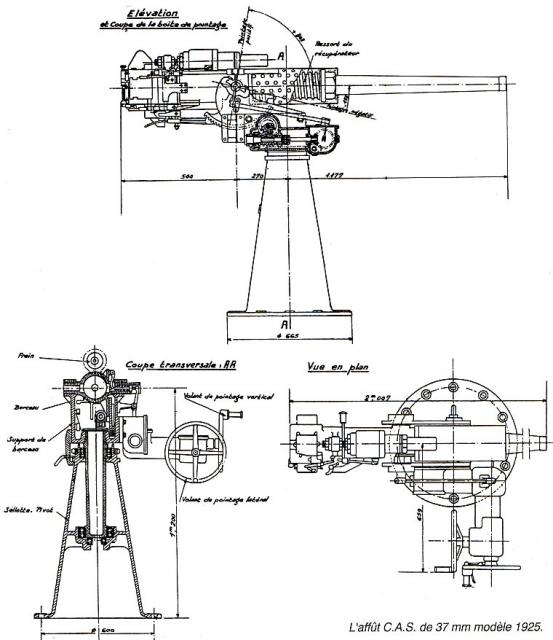
French 37 mm Modele 1925 plans
Unlike the Chacal class, the Guepard class received from the start, as designed, a pair of twin 37 mm AA guns and not the antiquated 75 mm Schneider AA guns provided initially. The 37 mm/50 (1.46″) Model 1925 was a new standard weapon used by the Marine nationale on all its 1930s vessels, from escorts to battleships. As a first generation intermediate caliber they were not satisfactory and for the ships which were modified in the USA under Free France, they were replaced by 40 mm Bofors.
Exact caliber was 54, not 50 as sometimes mentioned. This was replaced by the CAIL model 1933 later, with improved performances.
⚙ specifications 37mm/50 M1925 |
|
| Weight | 661 lbs. (300 kg) |
| Barrel length | 79.0 in (2.007 m), Bore 72.8 in (1.850 m) |
| Elevation/Traverse | -15/+80 degrees, 360° |
| Loading system | Welin breech Block |
| Muzzle velocity | 2,657 fps (810 mps) |
| Range | 7,850 yards (7,175 m) a 45° |
| Guidance | Optical + FCS |
| Crew | 3 |
| Round | 6.2 lbs. (2.8 kg) full HE Model 1925 1.6 lbs. (0.725 kg), Incendiary. |
| Rate of Fire | 30-42 (15-21 practical) |
Torpedo Tubes
Same arrangement and models as the previous Chacal class. Thye had one mount between the two pairs of funnels and another aft of the rear funnel.
23D/DT 550mm TORPEDOES
The Toulon’s 23D model, and later 23DT were also declined for submarines as the 24V/24M.
The 23D was introduced in 1923 hence the name, “D” standing for destroyers, and DT for destroyer leaders. They were otherwise identical and intorduced a far more efficient propulsion, albeit speeds were average.
This was the standard torpedo also for cruisers, and active in WW2 albeit in 1940 was searched an Oxygen-powered model capable of 40-55 knots and up to 18 km or 19.700 yards. Developed became underground and stopped completely in 1944.
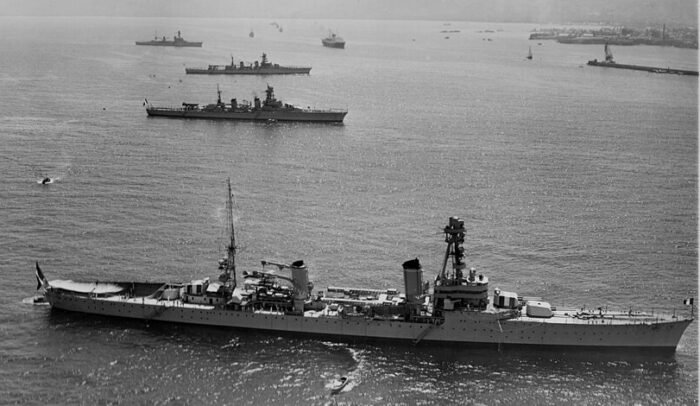
French squadron of the Mediterranean in June 1939 in Beyrouth
⚙ specifications 23D/DT TORPEDO
Weight: 4,560 lbs. (2,068 kg), for 27 ft. 2 in. (8.280 m) x 500 mm (21.7 inches).
Warhead: 683 lbs. (310 kg) TNT
Powered by a Schneider alcohol fed air heater, 4-cyl.
Speed settings: 9,840 yards/39 kts or 14,200 yards (13,000m)/35 kts
More

Destroyer Guepard -ONI203 booklet for identification of ships of the French Navy -PD (cc)
French Depth Charges
The poop featured dedicated chutes. They however had a basic hydrophone and no sonars. Thes internal chutes made the poop deck “cleaner”, protecting these from a direct hit that could have detonated these depht charges out on the open. They were dropped along guides ending short above the “beak” wwhere the poop reversed underwater. This perculiar arrangement was to avoid any return and contact with the poop. This system might have been used to lay mines of the same size by the way.
The depht charge used were the Guiraud Model 1922.
Introduced in 1923, they Weighted 573 lbs. (260 kg) for a 441 lbs. (200 kg) charge for 50 x 88 cm (19.7 x 34.6 in).
Sink Rate or terminal velocity was 10 fps (3 meters per sec.) with 100, 165, 250 and 330 feet (30, 50, 75 and 100 m) settings, later augmented to 120m.
They were held in two Galle 12-DC roller chain racks at the poop, internal, 24 total, and two depth charge throwers on the aft weather deck. Other sources specified they carried instead 20 grenades of 250 kg, so 10 per chain rack.
They also had four depth-charge throwers (“Y-Guns”) abreast the fore funnel, suppplied with a dozen smaller Guiraud Mle 1922 100-kilogram (220 lb) depth charges.
The French DC projectors were WWI Thornycroft models purchased in 1918, replaced in 1930 by the French-built 100/250 M1928 mortar. Fixed on a trainable mounting it only could project the lighter 100 kg DC at 820 feet (250 m). In the late 1930s they were replaced by a much heavier system firing 200 kg DC about 200 feet (60 m), so standardized with the 1922 Guiraud model.
However these four depth charge throwers were removed in 1932. They were badly positioned while they tended to cause leaks in the hull when used due to the concussion. Two were reinstalled still after the war started in September 1939.
The freed space and weight was reserved for two Ginocchio towed anti-submarine torpedoes, which were never used in combat.
More on this
French Sonar
Space was reserved a French sonar system cancelled in September 1930. There was a project to incorporate a passive Walser acoustic locator system but only Panthère was actually fitted. This system comprised a set of two steel lenses, one set on each side of the ship and many diaphragms amplified ambient sound for the operator. Needless to say it was only usable when static or proceeding at a very slow speed, not chasing a submarine. It was removed in 1931 but the compartment was reused for a Type 123 ASDIC system installed in 1939–40, Panthère never received it however.
Modifications
Given their short career not many changes were made apart AA. In 1932 already, so after completion, their four Thornycroft DCT and 32 DCs were removed. In 1939 Bison was the first fitted with a british Type 124 sonar. In 1941, Guépard and Valmy saw the removal of their aft 550mm TT bank and addition in place of a twin 37mm/50 M1933, as well as two single 13.2mm/76 HMGs. The same was done on Verdun.
Appearance
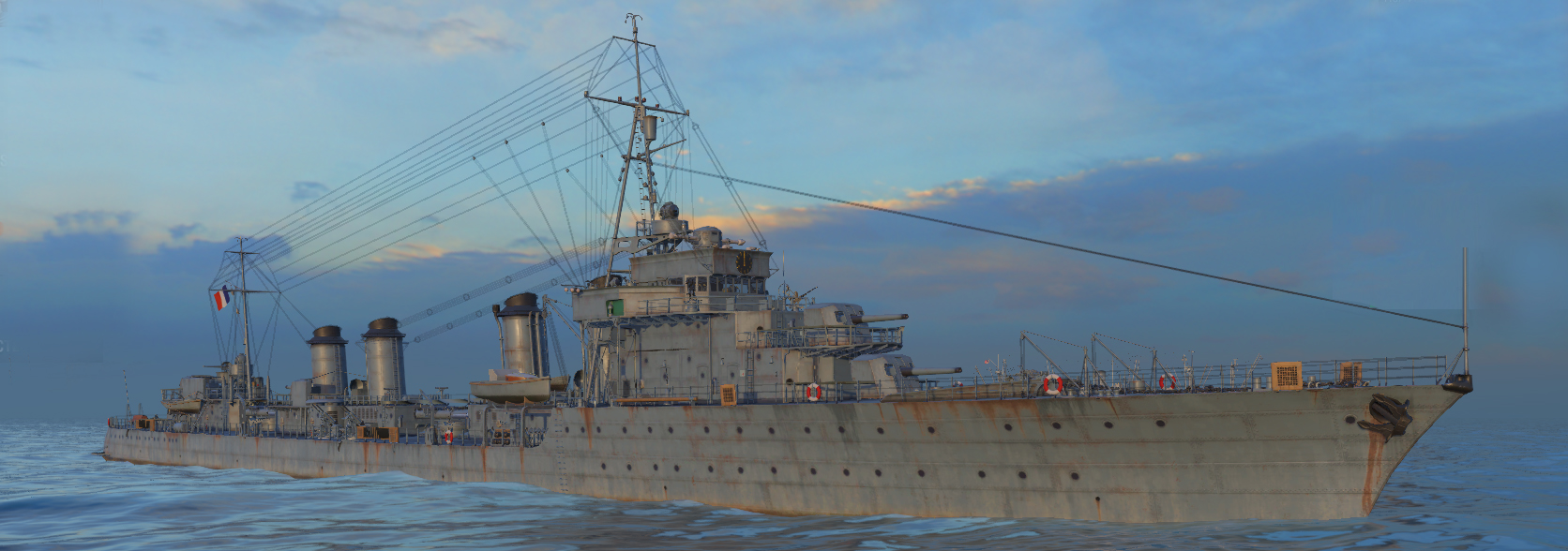

⚙ Guepard class specs. |
|
| Displacement | 2,436 t (2,398 long tons) standard, 3,220 t (3,170 long tons) full load |
| Dimensions | 130.2 x 11.5 x 4.3m (427 ft 2 in x 37 ft 9 in x 14 ft 1 in) |
| Propulsion | 2 shafts, geared steam turbines, 4 du Temple boilers 64,000 PS (47,000 kW; 63,000 shp) |
| Speed | 35.5 knots (65.7 km/h; 40.9 mph) (40 kts on trials) |
| Range | 3,000 nmi (5,600 km; 3,500 mi) at 15 knots (28 km/h; 17 mph) |
| Armament | 5× 138.6 mm/40, 4× 37 mm AA, 4× 13.2 mm AA, 2×3 550 mm TTs, 28 DCs |
| Sensors | Hydrophones. |
| Crew | 12 officers, 224 crewmen (wartime) |
Career of the Guepard class
 Guepard (1929)
Guepard (1929)

Guépard (“Cheetah”) was Built by Arsenal de Lorient, laid down on likely in March 1927, launched on 19 April 1928, and completed 13 August 1929. Logs for her interwar carer in research. On 8 May 1940 she departed Brest in escort of Convoy FP 5 for Greenock in Scotland and arrived 10 May. During World War II, after France’s surrender in June 1940, Guépard started service in the Vichy Navy. She notably took part in the Syrian campaign in 1941: On 9 June near Haifa, HMS Glengyle, HMS Ilex and HMS Hero were joined by HMS Isis and HMS Hotspur to take part of cover landing operations in Syria. At 10:05 a report from the Naval Liaison Officer with the Army notified two Vichy-French destroyers shelling Allied positions near Khan Bridge, Guepard and Valmy. HMS Coventry was detached and Force B closed the coast at full speed but misses the destroyers after a raid of just half an hour. HMS Janus and HMS Jackal joined HMS Isis and HMS Hotspur and stayed on site to protect the troops against a return of French destroyer, which happened at 13:39. Guepard and Valmy opened fire from 17,000 yards, Janus was the closest and answered at 15,000 yards. At 13:47 at 10:000 yards, HMS Janus was hit on the bridge, foremost boiler room and aft. All the bridge personnel except the CO were killed. No.1 boiler room stopped and she lost all electric power. She was again was hit twice, in No.1 boiler room notably. HMS Jackal passed in front with smoke to protect her. Other DDs arrived and saved the crippled Janus. On 14 June, Guepard and Valmy were spotted out of Beirut. They were spotted again off Beirut on the 16th and a small duelwith HMS Kimberley and Jervis ended under the shore batteries protection. Both ships were spotted again close to the entrance of the port on the 21st. She was reported again on 7 July with Valmy and Vauquelin out off the port, which was later captured by the allies. The destroyers were ordered to sail back to Toulon, not to sortie again. On November 1942, she was among the ships of the French fleet that was scuttled at Toulon on the 27th. She was part of the four destroyer of her class (Guépard, Lion, Verdun and Valmy) raised by Italians, assigned numbers, but never repaired. She was bombed and sunk by an US air raid on March 1944. Her wreck was scrapped postwar.
 Valmy (1928)
Valmy (1928)
Valmy (named after the battle of Valmy) was Built by Ateliers et Chantiers de St Nazaire-Penhoët, St. Nazaire, launched on 19 mai 1928, completed on 1 January 1930. During World War II saw three major escort missions before the fall of France: On 15 April 1940 she departed Brest in escort of Convoy FP 1 B for Greenock and Arrived there on 16 April. On 23 April same route, but for Convoy FP 3 also for Greenock in Scotland, arrived on 25 April. On 8 May she departed Brest with Convoy FP 5 for Greenock and arrived on 10 May. After France signed an armistice with Germany in June 1940, she entered service with the Vichy Navy. In late 1940 she was sent to Syria to defend the protectorate. She saw the same actions as her sister Guepard, see above, on 9 June hirring badly HMS Janus but repelled by smoke and a counter attack. She defended Beirut in June, but evacuated for France in July as the Levant was about to fell to the allies.
She was among the ships of the French fleet scuttled at Toulon, France, on November 27, 1942. Raised by the Italians, renamed FR 24, sent to La Spezia to be put to Italian standards, scuttled in September 1943, raised again by the Germans, scuttled at Genoa on 24 April 1945.
 Verdun
Verdun
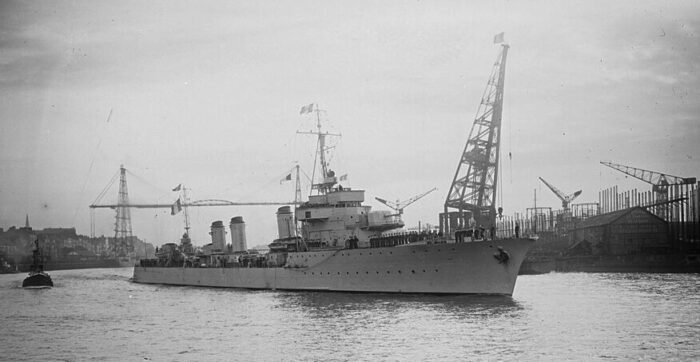
Verdun was named after the battle of 1916. She was Built by Ateliers et Chantiers de la Loire, St Nazaire, launched on 4 juillet 1928, completed 1 April 1930. During World War II she saw a few missions before the armistice: On 23 April 1940 she departed Brest in escort of Convoy FP 3 for Greenock and arrived on 25 April. By June 1940 she entered the Vichy Navy but apparently remained inactive for most of 1941-42. She was among the ships scuttled at Toulon on November 27, 1942. Raised in September 1943 but not repaired. Wreck raised again and scrapped postwar.
 Bison
Bison
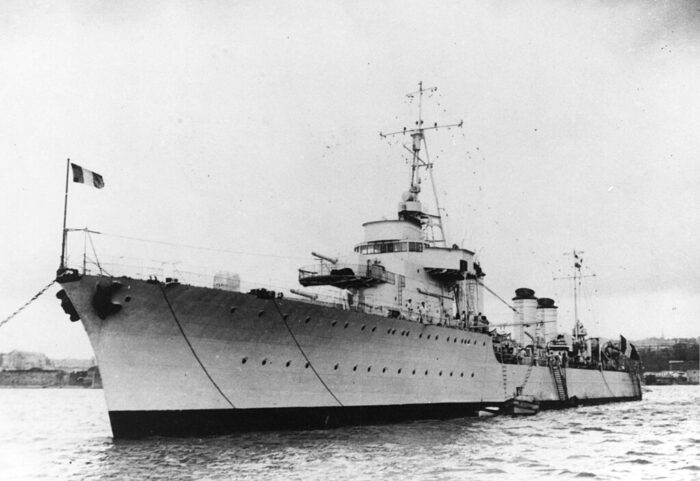
Bison was built by Arsenal de Lorient, launched on 29 October 1928 and completed 10 October 1930. She had the shortest but most intense career of all the class. Already on the night of 8 February 1939 she collided with light cruiser Georges Leygues and lost her fore end to the main gun No2. She was repaired. On 12 April 1940 under command of Capitaine de Vaisseau Jean Adolphe Roger Bouan in the 11e Division de Contre-Torpilleurs she departed Brest in escort of Convoy FP 1 A for Greenock, and arrived on 14 April. On 20 April 1940 she escorted the French transport Ville d’Alger with French troops from Scapa Flow for Namsos in company of Foudroyant (Cdr. P.L.A. Fontaine). This was the start of her Norwegian Campaign. The were later reinforced by Calcutta and Birmingham until they entered Namsen Fjord. Birminggham came back home but Calcutta left with the French ships.
She then took part in Operation Klaxon, a troop evacuation from Namsos, from 29 April to 5 May 1940. At 20:00 on the 29th, she ecorted the French AMC (armed merchant cruisers) El D’Jezair, El Kantara and El Mansour from Scapa Flow for Namsos, to evacutate troops, also escorted by HMS Kelly (Capt. L.F.A.V.N. Mountbatten, HMS Maori (Cdr. G.N. Brewer), HMS Imperial (Lt.Cdr. C.A.de W. Kitcat). A cover force later departed Scapa (HMS Devonshire, York, Montcalm (Capt. J.L. de Corbiere, flagship Contre-Admiral E.L.H. Derrien) and HMS Grenade, Griffin and Hasty. Later they were joined by HMS Afridi (Capt. P.L. Vian), HMS Nubian and French Foudroyant. The force was led by Vice-Admiral Cunningham and arrived on May 1st.
By the evening of 2 May HMS Devonshire, Montcalm, Grenade, Griffin, Hasty and Imperial remained at sea to cover the operation at Namsos. 1850 British, 2345 French, and some Norwegians were evacuated. The Luftwaffe attacked the Devonshire and Montcalm, not hit. However Bison was hit at 10:10 hours. Her forward magazine exploded, blowing off her forecastle. Survivors were rescued by Grenade, Imperial and Afridi and she was scuttled by the latter. She was in turn hit and sank.
 Lion
Lion
Lion was Built by Ateliers et Chantiers de France, Dunkirk, launched on 29 octobre 1928, completed 21 January 1931. No logs for her interwar career. On 29 April 1940 she was present at Mers El Kebir when a RN squadron arrived (HMS Malaya, Royal Sovereign, DDs Velox, Watchman, Vendetta, Waterhen. Lion (Cdr. J.J.A. Vetillard) and Lynx, Forbin escorted the battleships Lorraine, Bretagne, Provence, the heavy cruisers Tourville, Duquesne, light cruiser Duguay Trouin . The following day they were joined from Malta by Stuart, HMAS Vampire, the cruiser HMS Orion, DDs HMS Decoy, Defender to Alexandria, to reinforce the Mediterranean Fleet. On 3 May, they arrived at Alexandria.
No logs for what happened later. Lion was sent bacl like her division and stayed in Toulon in 1941-42. She was scuttled in November, seized by the Germans, raised and later repaired by the Regia Marina and renamed as FR 21. She was sent to La Spezia to be put to Italian standards, but never operational. She was scuttled by the Italians to prevent capture by the Germans in September 1943 at their own armistice. Refloated once again by the Germans in 1944 she was apparebtly used as a towed, static vessel, sent to genoa where she was scuttled once again. Wreck scrapped postwar.
 Vauban
Vauban
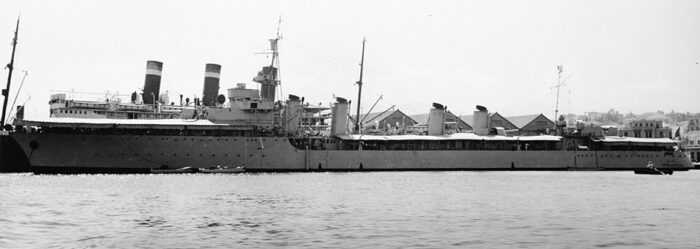
Vauban (named after Marshal Sébastien Le Prestre de Vauban) was built by Ateliers et Chantiers de France, Dunkirk, laid down on 22 May 1927, launched on 1 February 1930 and completed 9 January 1931. She saw service in the Vichy Navy until scuttled at Toulon on November 27, 1942, wreck apparently not raised by the Italians, left in her state until raised postwar and scrapped.
Read More/Src
Books
Cernuschi, Enrico & O’Hara, Vincent P. (2013). “Toulon: The Self-Destruction and Salvage of the French Fleet”. In Jordan, John (ed.). Warship 2013.
Chesneau, Roger, ed. (1980). Conway’s All the World’s Fighting Ships 1922–1946. Greenwich, UK: Conway Maritime Press.
Jordan, John & Moulin, Jean (2015). French Destroyers: Torpilleurs d’Escadre & Contre-Torpilleurs 1922–1956. Barnsley, UK: Seaforth Publishing.
Rohwer, Jürgen (2005). Chronology of the War at Sea 1939–1945: The Naval History of World War Two (Third Revised ed.). NIP
Whitley, M. J. (1988). Destroyers of World War Two: An International Encyclopedia. NIP
Jean Mauclère, La campagne du Bison, J de Gigord, coll. « L’étrave », 1946
Henri Darrieus et Jean Quéguiner, Histoire de la Marine française (1922-1942), L’Ancre de Marine, 1996
Links
navypedia.org guepard.htm
en.wikipedia.org Guepard class destroyer
navweaps.com/ 155mm/40 m1923
uboat.net/
uboat.net: Guepard
gallica.bnf.fr abordage du bison par le georges leygues

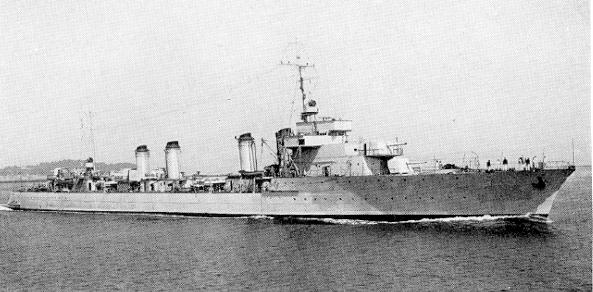

 Latest Facebook Entry -
Latest Facebook Entry -  X(Tweeter) Naval Encyclopedia's deck archive
X(Tweeter) Naval Encyclopedia's deck archive Instagram (@navalencyc)
Instagram (@navalencyc)





 French Navy
French Navy Royal Navy
Royal Navy Russian Navy
Russian Navy Armada Espanola
Armada Espanola Austrian Navy
Austrian Navy K.u.K. Kriegsmarine
K.u.K. Kriegsmarine Dansk Marine
Dansk Marine Nautiko Hellenon
Nautiko Hellenon Koninklije Marine 1870
Koninklije Marine 1870 Marinha do Brasil
Marinha do Brasil Osmanlı Donanması
Osmanlı Donanması Marina Do Peru
Marina Do Peru Marinha do Portugal
Marinha do Portugal Regia Marina 1870
Regia Marina 1870 Nihhon Kaigun 1870
Nihhon Kaigun 1870 Preußische Marine 1870
Preußische Marine 1870 Russkiy Flot 1870
Russkiy Flot 1870 Svenska marinen
Svenska marinen Søværnet
Søværnet Union Navy
Union Navy Confederate Navy
Confederate Navy Armada de Argentina
Armada de Argentina Imperial Chinese Navy
Imperial Chinese Navy Marinha do Portugal
Marinha do Portugal Mexico
Mexico Kaiserliche Marine
Kaiserliche Marine 1898 US Navy
1898 US Navy Sovietskiy Flot
Sovietskiy Flot Royal Canadian Navy
Royal Canadian Navy Royal Australian Navy
Royal Australian Navy RNZN Fleet
RNZN Fleet Chinese Navy 1937
Chinese Navy 1937 Kriegsmarine
Kriegsmarine Chilean Navy
Chilean Navy Danish Navy
Danish Navy Finnish Navy
Finnish Navy Hellenic Navy
Hellenic Navy Polish Navy
Polish Navy Romanian Navy
Romanian Navy Turkish Navy
Turkish Navy Royal Yugoslav Navy
Royal Yugoslav Navy Royal Thai Navy
Royal Thai Navy Minor Navies
Minor Navies Albania
Albania Austria
Austria Belgium
Belgium Columbia
Columbia Costa Rica
Costa Rica Cuba
Cuba Czechoslovakia
Czechoslovakia Dominican Republic
Dominican Republic Haiti
Haiti Hungary
Hungary Honduras
Honduras Estonia
Estonia Iceland
Iceland Eire
Eire Equador
Equador Iran
Iran Iraq
Iraq Latvia
Latvia Liberia
Liberia Lithuania
Lithuania Mandchukuo
Mandchukuo Morocco
Morocco Nicaragua
Nicaragua Persia
Persia San Salvador
San Salvador Sarawak
Sarawak Uruguay
Uruguay Venezuela
Venezuela Zanzibar
Zanzibar Warsaw Pact Navies
Warsaw Pact Navies Bulgaria
Bulgaria Hungary
Hungary

 Bundesmarine
Bundesmarine Dutch Navy
Dutch Navy Hellenic Navy
Hellenic Navy Marina Militare
Marina Militare Yugoslav Navy
Yugoslav Navy Chinese Navy
Chinese Navy Indian Navy
Indian Navy Indonesian Navy
Indonesian Navy JMSDF
JMSDF North Korean Navy
North Korean Navy Pakistani Navy
Pakistani Navy Philippines Navy
Philippines Navy ROKN
ROKN Rep. of Singapore Navy
Rep. of Singapore Navy Taiwanese Navy
Taiwanese Navy IDF Navy
IDF Navy Saudi Navy
Saudi Navy Royal New Zealand Navy
Royal New Zealand Navy Egyptian Navy
Egyptian Navy South African Navy
South African Navy






























 Ukrainian Navy
Ukrainian Navy dbodesign
dbodesign